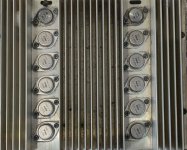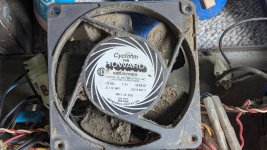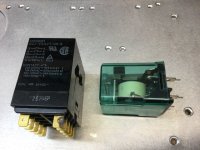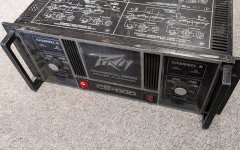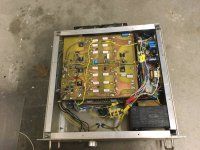It looks like they translate to Motorola MJ15015s and RCA 1B09s. Robust.
Original, untouched CS-800 from 45 years ago. Neat.
Original, untouched CS-800 from 45 years ago. Neat.
When I replace a fan that might have operated 12 h a day 6 days a week for 40 years, I buy one that has ball bearings.This one is a keeper. I don't think they make them like that anymore 40+ years old. It cleaned up just fine.
It looks like they translate to Motorola MJ15015s and RCA 1B09s. Robust.
Original, untouched CS-800 from 45 years ago. Neat.
I wouldn’t go so far as to call MJ15015 “robust”. It’s a POS. Peavey did use it, but NOT in the CS amps. SJ6387 is MJ13330, a 20 MHz switching transistor. Very rugged as far as switching transistors go. Full power capability at 20V and still good for over an amp at Vce=40. It’s good as a driver, where you only need high current at low Vce when the outputs are running out of beta. Having higher speed drivers usually gives less problems with stability, so it was a good call.
The 1B09 eventually became RCA’s version of the MJ15024. RCA had ballasted multiple epitaxials long before Motorola did. Their earliest versions (2N5240) just had severe quasi-saturation and you HAD to parallel a bunch of them to combat beta droop - look at the hFE curves if you can get an old RCA data book, they are abysmal. They got better by 1984, though.
Just build a speaker relay board. Contrary to popular belief, they work just fine. If you use a relay like THIS and not some cheesy little thing the size of your thumbnail.
If you used actual MJ15024 outputs, a sustained shorted output will survive with the normal built in SOA protections. Those 68271’s will too. SJ6343 not so much. They will survive momentary speaker wire shorting, like plugging/unplugging 1/4” jacks hot. But a sustained short from the crowbar will take ‘em out.
If you used actual MJ15024 outputs, a sustained shorted output will survive with the normal built in SOA protections. Those 68271’s will too. SJ6343 not so much. They will survive momentary speaker wire shorting, like plugging/unplugging 1/4” jacks hot. But a sustained short from the crowbar will take ‘em out.
Attachments
You've inspired me to fire it up. It has been here for a year and I finally got around to it.
Wow, what a tremendous amount of power. Of course in my living room such an amplifier can never run out of power. I could never get it to clip at home, indoors. It is clean, unadulterated power. Crazy clean bass. Overall sounds fantastic on a vintage Nikko 80s preamp and a vintage 90s Toshiba CD player driving a pair of Dayton Audio custom bass reflex two-ways. No buzz or hiss when opened up full. 1.8 mV DC offset on one channel and 3.6 mV DC offset on the other. Switches work. Pots are clean & clear. Hi-Low fan works and does not make any loud noise. Perhaps toss it on the Quant Asylum for a distortion test.
Such a terrible-looking thing but it plays exceptionally well. Worth $100 all day every day. I wonder what I can get for it. It has to go now that the binding posts are replaced and the unit is tested and cleaned.
I thought it was cool looking in the early 80s but its pretty ugly by todays standards. And the hellacious wiring inside that box is beyond anything I ever imagined. I vote the CS-800 to have the worst internal wiring of any amplifier of all time. Ha
But it plays well and loud. Fun!
A good day for me.
Cheers.
Wow, what a tremendous amount of power. Of course in my living room such an amplifier can never run out of power. I could never get it to clip at home, indoors. It is clean, unadulterated power. Crazy clean bass. Overall sounds fantastic on a vintage Nikko 80s preamp and a vintage 90s Toshiba CD player driving a pair of Dayton Audio custom bass reflex two-ways. No buzz or hiss when opened up full. 1.8 mV DC offset on one channel and 3.6 mV DC offset on the other. Switches work. Pots are clean & clear. Hi-Low fan works and does not make any loud noise. Perhaps toss it on the Quant Asylum for a distortion test.
Such a terrible-looking thing but it plays exceptionally well. Worth $100 all day every day. I wonder what I can get for it. It has to go now that the binding posts are replaced and the unit is tested and cleaned.
I thought it was cool looking in the early 80s but its pretty ugly by todays standards. And the hellacious wiring inside that box is beyond anything I ever imagined. I vote the CS-800 to have the worst internal wiring of any amplifier of all time. Ha
But it plays well and loud. Fun!
A good day for me.
Cheers.
Attachments
We had Phase Linears for “cool looking” in the 80’s. For driving bass bins we wanted the CS800’s. About the best amp for “war volume” that was anywhere near affordable. Ones with four dead banks of S6343’s and two blown crowbars could be had for $100 or less back then (and ones that worked $800). Twenty four 2SD424’s later (and one speaker relay) it would be making bass. All the repair shops wanted $33 a pop for ECG284’s so when they were “that dead” they got dumped.
War volume, ha I love it. You & Burnedfingers and anatech have the best stories. Dudes that lived it. Fantastic.
Where is the wiring diagram to instruct me to install a relay with the nasty crowbar circuit? I don't know anything about it.
I could do that relay favor for the world & amp at a low cost to me, I think.
I have had it cranked for hours. As loud as I can go in the room. It's wash & wear. Ready to rock some bins.
Where is the wiring diagram to instruct me to install a relay with the nasty crowbar circuit? I don't know anything about it.
I could do that relay favor for the world & amp at a low cost to me, I think.
I have had it cranked for hours. As loud as I can go in the room. It's wash & wear. Ready to rock some bins.
No, you don’t install a relay on the crowbar circuit. Ditch the whole circuit. Make four comparators out of a TL084 for the DC detection, diode-OR the outputs and use it to trigger a 555 timer. That triggers the relay. The 555 also gives you the delayed start. I made these boards for my “KM441”, and later adapted it for pretty much everything else. Installed them everywhere. My “CS800 clone” still has this, as do the bigger ones that followed. The relay is right in the center, in front of the clamshell heat sinks. Dropped mics open it right up, and so does hitting the input with 12VDC (even AC coupled, produces a hell of a transient with a long time constant).
Attachments
Oh well... I shall leave it as is. It seems to be mint other than the enclosure.
Thanks for the input. Time to unload this on somebody with big subs.
Thanks for the input. Time to unload this on somebody with big subs.
So I was kind of joking about RCA designing the CS-800 but apparently, I was not far off the mark as there was an RCA dude, Jack Sondermeyer, who helped design the Peavey & BGW amps that remarkably share that, at-the-time unique heat sink fan cooling setup. How did those two brands share that same physical/electronic arrangement without conflict? Jack Sondermeyer went to Peavey yet BGW had clones of his work?
- Home
- Live Sound
- Instruments and Amps
- Peavey CS-800 Issues
